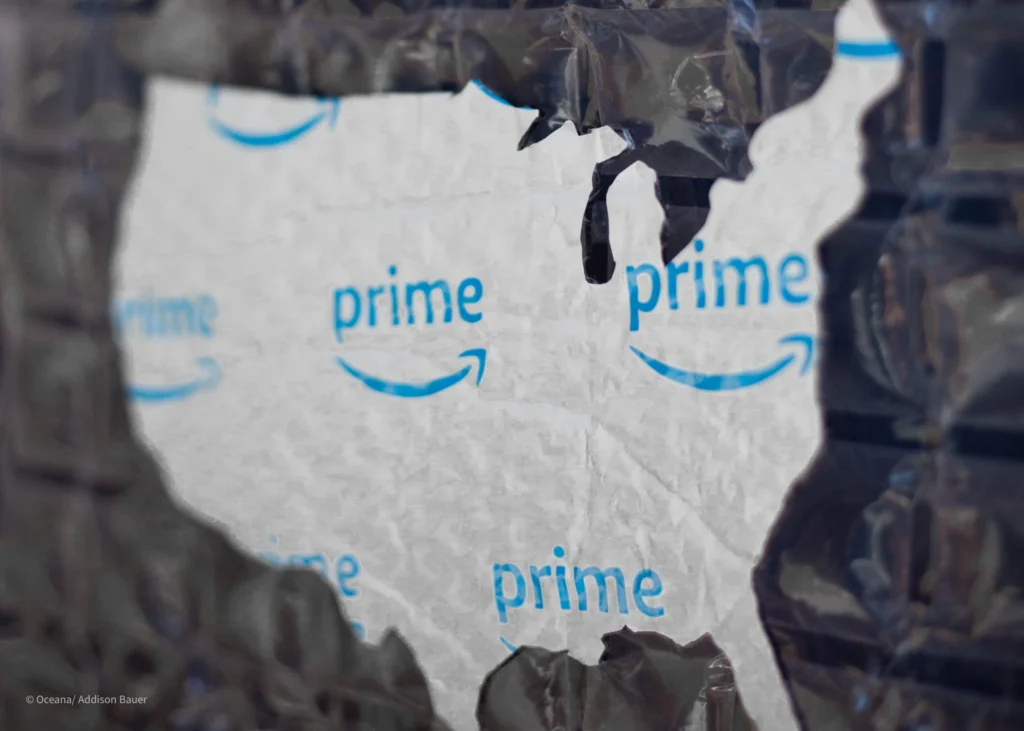Amazon’s global plastic footprint might be shrinking, but the US is a different story

Oceana released a new report, “Amazon’s United States of Plastic,” which estimates that Amazon generated 208 million pounds of plastic packaging waste for all transactions in the United States in 2022, a 9.6% increase over Oceana’s estimate for 2021. This amount of plastic, in the form of air pillows, would circle the Earth more than 200 times.
Oceana calculated the amount of plastic packaging waste generated by Amazon in the U.S. based on available market data, making adjustments informed by recent public communications from the company about changes in its plastic packaging use. For the years 2021 and 2022, Amazon disclosed part of its global plastic packaging footprint but has neither reported its plastic use at the country level, nor for all transactions including those fulfilled by third-party sellers.
“Amazon’s failure to reduce plastic in the U.S. is troubling. The company has dramatically reduced plastic packaging in other major markets including India and Europe. Why are U.S. customers being left behind? According to research by YouGov, 85% of Amazon customers in the U.S. reported being concerned about plastic pollution. It’s time for Amazon to step up and commit to a global plastic packaging reduction everywhere it operates — including in the U.S.,” said Matt Littlejohn, Oceana’s Senior Vice President for Strategic Initiatives.
Amazon has reported that it reduced the total amount of plastic delivery packaging it used for orders shipped through its global operations network by 11.6% in 2022 compared to 2021. This is largely due to its efforts to reduce plastic packaging outside of the U.S. For example, in Europe, the company has claimed it replaced single-use plastic delivery packaging with 100% recyclable paper and cardboard packaging throughout its fulfillment network.
Because the company refuses to phase out plastic packaging everywhere it operates, Oceana estimates that a large amount of plastic packaging continues to become marine plastic pollution. Using plastic waste pollution data from a peer-reviewed study published in the journal Science in 2020, Oceana estimates that up to 22 million pounds of Amazon’s global plastic packaging waste from 2022 will end up in the world’s waterways and seas.
Plastic pollution, including the type of plastic used in Amazon’s packaging, is devastating the world’s oceans. Amazon’s plastic packaging is made from the most common form of marine plastic litter in nearshore ocean areas — plastic film — which is also the deadliest type of plastic to large marine animals.
The company’s shareholders have repeatedly called for Amazon to outline a company-wide plan for reducing its plastic footprint by at least one-third. Phasing out plastic packaging in the U.S. as the company has in other major markets would help Amazon achieve this goal.
Related Article: Amazon and ENGIE Sign Major Deal for 473MW from Moray West Wind Farm
“As one of the biggest retailers on the planet, Amazon is increasingly defining how our goods are packaged. The company can solve its plastic problem on a global basis now and into the future if it commits to do so — and follows through,” Littlejohn added. Oceana calls on Amazon to phase out plastic packaging in its largest market — the United States— and make a company-wide commitment to reduce the total amount of plastic packaging it uses by at least one-third by 2030.












